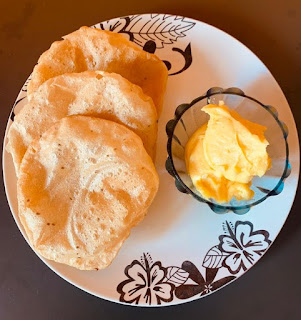Gudi Padwa is celebrated on the first day of the Chaitra month of the Hindu calendar. It is the first day of the year for people of Maharashtra and Konkan region. Gudi Padwa gets it's name from two words, the word Gudi means a flag and Padwa is derived from a Sanskrit word Pratipad which refers to the first day of the bright phase of the moon. This festival is celebrated with family. People worship Lord Brahma and Goddess Saraswati on this day.
- Wooden pooja chowky
- one big stick (Bamboo)
- one saree or any cloth(red or green or yellow)
- one whole coconut
- Betel leaves
- Batasha (a sweet made up of sugar)
- Mango tree leaves
- Kalash (tie a thread five times on the neck of it and draw KumkumSswastik on it)
- Flowers
- Haldi, Kumkum, Akshada (rice)
- Incense sticks
- Diya
- Toran made up of Mango leaves and marigold flower garland
- A bunch of Neem leaves
- Clean houses and courtyards.
- This Pooja vidhi is performed in the morning.
- Draw beautiful Rangoli at the entrance of the house
- First perform a regular pooja of all the deities
- The Gudi is made by tying a Saree on to a long bamboo stick. Take a Bamboo stick, clean it properly and apply five kumkum tikkas over it (on the top)
- On top of the cloth, neem leaves, Batasha mala or gathi (a Maharashtrian sweet preparation), a garland of red or yellow flowers and a twig with mango leaves are tied on the top of the bamboo stick. This stick with the various ornaments is topped off with an inverted silver or copper pot (Kalash).
- Put the Kalash on the top of the stick (as shown in image below). Apply kumkum Swastik on the kalash.
- Now place the Chowky at the entrance and draw small Swastik below it. Decorate the chowky with flowers and also draw Rangoli around it.
- Cover the Chowky with any colored cloth and spread some rice on it (in the center of it).
- Finally keep the Gudi on that rice (on chowky)
- Put two betel leaves (one top of the other) with one betel (Supari) on it.
- Keep one coconut beside Gudi. Apply Haldi kumkum to it.
- Offer prayer to Lord Bramha and Goddess Saraswati.
- Gudi can be placed outside the window or in balcony also.












Nice info...
ReplyDeleteBeautiful staart of the year by reading your post Prerna!! Thank You.
ReplyDelete